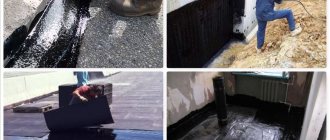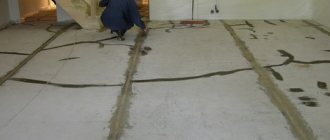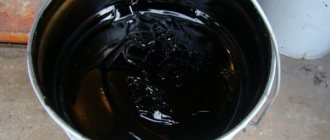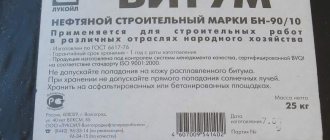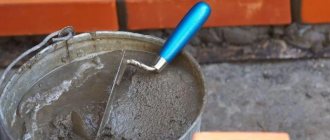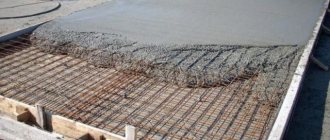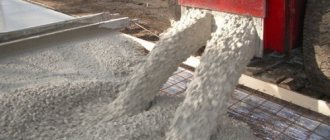A building material such as bitumen has been used for pouring roofs for a very long time. Perhaps the reason for the popularity of bitumen is its cheapness. But if you prefer it to other more expensive materials, do not forget that bitumen is short-lived. Direct sunlight and rays pose a particularly great danger to it, as this causes it to begin to melt and flow. And in winter, due to severe frosts, it cracks and this can cause leaks in the garage roof.
But if you still decide to use a building material such as bitumen, then we will consider the process of preparing it for pouring.
In order to prepare about 10 kg of bitumen mastic, you will need:
- 8.5 kg bitumen
- 1 kg of filler (it can be peat chips, asbestos, chalk sawdust, crushed mineral wool, etc.)
- 0.5 kg of used crankcase oil.
It is best to cook the bitumen mixture in a thick-walled boiler with a tightly closed lid. In thin-walled containers, bitumen can burn.
The bitumen should be heated gradually over low heat.
The heating temperature of bitumen ranges from 160-200 degrees. Heat for 1-3 hours depending on the heating temperature, the higher it is, the less we heat the bitumen.
At temperatures above the specified maximum (220 and above), coke is formed in the bitumen, which significantly worsens the properties of the bitumen (it can crack).
The surest sign of bitumen overheating is the appearance of green-yellow smoke and bubbles.
Cook the bitumen until smooth and a glossy surface appears.
After this, remove it from the heat and add filler and crankcase oil in small portions. And immediately we begin to carefully pour hot bitumen onto the garage roof, which by this moment must be thoroughly cleaned of all kinds of contaminants, dried and prepared for pouring. When applying bitumen, we use kvatch or apply bitumen in bulk.
Then roofing material is glued onto the hot bitumen to further prevent overheating of the bitumen in the sun.
You can cook bitumen for pouring roofs yourself over a fire, take a barrel or a large pan (since you usually need a lot of bitumen), take 10 kg of resin, a liter of waste (motor oil, can be purchased at a service station) and a kilogram of construction chalk.
We put the bricks on an edge, a container on it, resin in the container (put about a couple kilos, and then when it melts, add the rest), light a fire under the container, using small wood chips (try to keep the fire low so that the resin melts and does not boil around straightened pieces.
As soon as the resin melts a little at a time, add chalk and pour in the waste, stir thoroughly - everything is ready, you can resin the roof and glue the roofing felt.
The prepared bitumen will harden in the container when it cools; it can be reheated and used.
Filling the roof with bitumen is a necessary task and this work must be done so that you don’t have to return to it for a long time, so that there are no leaks. And this is done simply the old fashioned way, so to speak. We take a large old container - for example, an iron barrel, throw pieces of bitumen into it (it’s better to make smaller pieces), put it on a tripod and light a blowtorch and let the bitumen melt completely. Then we add waste (this is used machine oil) to the bitumen, stir thoroughly, and then chalk and stir too. The proportions are: 10 kg. bitumen; ! liter of waste; 1 kg chalk.
The foundation of the house is subject to constant destructive influence from various environmental factors. Particularly active is the water that is contained in the soil and penetrates into it after precipitation. When constructing the foundation, it is necessary to provide additional protection from this influence. The most commonly used is bitumen mastic.
Why is coating waterproofing with bitumen necessary?
In its classic form, bitumen mastic is a mixture of several components that reliably and tightly cement cracks in the surface of the base and prevent moisture from penetrating into the foundation structure.
The mastic hardens quickly due to the use of various solvents and other elements that ensure the effectiveness of the solution. Using mastic it is possible to create highly effective seamless surfaces. This is true for the roof and walls, and certainly for the foundation.
Before using mastic, it is important to know how and with what to dissolve the resin for painting the foundation. The effectiveness of the subsequent operation of the protective layer depends on the correct combination of elements.
How to dilute bitumen mastic
To find out exactly how to dilute resin for painting the foundation, you need to understand what indicators you want to get. The proportions in which the components in the mastic are combined determine not only the thickness, but also the performance characteristics of the solution. Among the substances used to dissolve the mastic, the following are used:
- Gasoline (kerosene).
- White Spirit.
- Gasoline galoshes (Gasoline solvent for the rubber industry).
Choosing the right substance and amount of material that needs to be used to dilute bitumen for the foundation means preparing the optimal material for processing the foundation.
How to remove bitumen stains from a car
On cars, splashes and drops of bitumen resins appear on the lower parts of the wings, arches and front bumpers (a gift from the vehicle driving ahead). Undesirable resinous tuning is revealed when it has already petrified and become as durable as a metal tile corner, except that it shines less.
Bitumen is resistant to water of any temperature and most water-containing solvents. They are easily removed by benzene, carbon disulfide and other organic solvents - turpentine, white spirit, etc. Before removing bitumen stains from a car, you need to make sure that the car enamel is resistant to the selected solvent. It is best to buy special “Bitumen stain cleaner” or Profam 3000, but be sure to buy branded bottles. These compounds do not leave marks on the varnished surface of the wings and on the chrome hoods.
If a special cleaner is not available, use kerosene or diesel fuel to remove bitumen from your car; they do not interact as actively with car enamel as standard gasoline. Small and rare bitumen splashes can be removed with ordinary butter if you are patient. The place where the bitumen stain was located will need to be polished, otherwise its shade will be discordant with the main color of the car paint.
What additives are used to dilute mastic?
It is possible to add various filler options to the created solution. Therefore, the builder should decide what parameters he wants to achieve in the end.
Now the most popular types of mastic are the following:
- bitumen-rubber mastic,
- polyurethane,
- latex,
- oil, rubber.
If we take bitumen-rubber mastic, then its composition is based directly on bitumen and polymer.
Polyurethane and rubber form additional plasticity in the solution, in which the resulting film is not only durable, but can stretch approximately 20 times.
The use of rubber to prepare a cold mixture allows you to create a material that does not require preparation before use. The mastic is applied evenly and is uniform and durable.
The addition of oil components helps prevent the material from hardening. Such compositions are necessary for waterproofing pipes and pipes that will be placed underground.
Cooking features
The process of making bitumen mastic is not complicated; you just need to choose the right ingredients and follow the basic rules of preparation.
To complete the work, the following elements are required:
- pieces of bitumen, cleaned of contaminants;
- specially selected fillers,
- various plasticizers.
For example, to create waterproofing you need to have approximately 10 kilograms of mastic. This will require approximately 8 kg of bitumen, 1 kg of filler and 500 grams of plasticizer.
For cooking mastic, durable cauldrons with a wall thickness of 3 mm or more are selected. There should also be a lid. Thanks to the heating of the walls, the bitumen warms up evenly.
The boiler should be loaded no more than 70% - otherwise the mastic may start to splash out. For cooking, the following rules must be strictly followed:
- The boiler is not placed above the fire, but is installed to the side.
- The temperature should be at 190 degrees, which does not lead to decomposition of the material.
- Temperature changes are unacceptable, which can lead to the formation of a heterogeneous mass of mastic.
- To prepare the mixture as quickly as possible, it is necessary to divide the bitumen into small pieces.
- Cooking the mastic should occur slowly and evenly.
- Filler and additives should also be crushed.
- The addition of components is carried out gradually.
- The solution is stirred regularly and the forming foam is periodically removed.
- After the foam disappears, fillers can be added.
- After adding, the resulting solution is thoroughly stirred - and the bitumen mastic is ready for use!
Now that you have learned how to dilute bitumen mastic for the foundation and how to prepare it, you should know how to apply it to the surface correctly.
How to apply bitumen mastic correctly
After preparing the mastic, it should be applied correctly to the surface. There are 2 methods for this:
- Application by hand.
- Mechanized method of application using special tools.
The manual method of work is optimal when performing a small amount of work. For large areas of work, manual technology is impractical, so mechanisms are used. The tools are also used to work in hard-to-reach places.
Before application, the surface to be treated should be prepared. The surface is cleaned and thoroughly dried. After this, a thin layer of primer is applied, which ensures interaction with the mastic.
Once the mixture is ready and sufficiently warmed up, you can proceed directly to application. To do this, use a regular roller or brush - the choice of a specific tool depends on the nature of the surface, volume and complexity of the configuration of the foundation, wall or roof. Sometimes a wide spatula is used for application.
The layers of mastic are applied with an overlap, which should be approximately 10 centimeters. This prevents the formation of empty parts that will be exposed to moisture penetration.
The application of the next layer of mastic begins after the previous one has completely hardened.
The use of bitumen mastic for waterproofing the base is an important factor in protecting the structure and preventing the formation of microcracks and damage.
Mastic is a universal waterproofing material widely used during construction work. This material is a product of bitumen remelting, devoid of such disadvantages of bitumen as brittleness in frost and excessive fluidity in extreme heat. The mastic has a fairly viscous consistency, so it can be applied to vertical surfaces in a fairly thin layer. Over time, this layer does not float.
Mixing with Gilsonite for elasticity
The technology of mixing Gilsonite with hot mix bitumen is one way to change its properties, such as softening point and penetration, to values that cannot be produced in a refinery.
The following questions need to be considered regarding this issue:
- Gilsonite bonds very well to any bituminous material.
- Grinding is required before mixing Gilsonite into the hot mixture.
- Of all types of natural bitumen, Gilsonite has the highest solubility in TCE (bitumen content), which avoids deterioration in the quality of the final product, especially compared to pyrobitumen.
- Temperature and mixing time are two inverse variables: the lower the temperature applied to the hot mix, the longer it will take to properly mix the Gilsonite with the bitumen or slurry.
- Since the procedure is aimed at a more economical approach, the use of expensive products in this process is not possible.
Bitumen is a black or dark, amorphous, cementitious material that can be found in various forms such as rock asphalt, natural bitumen, tar and petroleum-derived, which is referred to as petroleum.
We invite you to familiarize yourself with Crochet washcloth: step-by-step knitting with elongated loops
The latter is often called asphalt. For example, in Europe this term means a liquid binder. In North America, on the other hand, the liquid binder is called asphalt or asphalt cement.
Currently, most roads in the world are paved with bitumen. Today, global demand is more than 100 million tons per year, which equates to approximately 700 million barrels of bitumen consumed annually.
DIY mastic
To make mastic yourself, you will need:
- pieces of pure bitumen,
- fillers,
- plasticizers.
Let's say you want to get 10 kilograms of the finished mixture. Then take 8.5 kg of pure bitumen, 1 kg of filler (forest moss or sawdust, peat, mineral wool, rubber crumbs, asbestos), 0.5 kg of plasticizer (waste oil). It is best to cook mastic in special cauldrons equipped with thick (at least 3mm) walls and a lid. Such walls will allow the heat to be evenly distributed so that the bitumen does not burn.
Cooking rules
- The boiler can be loaded no more than 70%. Otherwise, the mastic may spill out.
- The boiler must be installed not directly on the fire, but away from it on a stand.
- It is best to maintain the cooking temperature within 190C. At higher temperatures, bitumen may decompose.
- Try to avoid temperature changes - in the end you will end up with a mastic that is homogeneous in composition. How do you know if the temperature is too high? Very simple. The first sign of overheating is the appearance of yellow-green bubbles.
Cooking process
- Before starting cooking, crumble large pieces of bitumen into smaller ones, clean them of dirt and sand.
- The entire process of melting bitumen should proceed very slowly, over about three hours.
- The filler must be crushed, dried and heated.
- Fillers and plasticizers should be introduced gradually.
- The boiling mixture must be stirred regularly (using a shovel) and the foam removed from it.
- After the foam has subsided and the surface of the mixture becomes completely smooth, you can add a plasticizer.
- Then mix everything thoroughly again.
- That's it - the mastic is ready.
Best before date
It is advisable to boil the mastic immediately before using it. It cannot be stored longer than 24 hours. During use, the mastic must always be hot (approximately 120 ° C).
How to dissolve bitumen - a little theory
Bitumen is one of the oldest building and insulating materials; humanity learned to use it earlier than cement and baked clay bricks. Natural bitumen is not used in its pure form, but it is more than widely found in the form of industrial mixtures. Bitumen-based compositions are as follows:
- Primers - for preliminary impregnation of interfloor and rafter structures. Such bitumens are relevant when installing wooden floors between floors and multi-layer roof finishing;
- Adhesive – for reliable gluing of roll-type roofing materials in conditions of high humidity for future use;
- Waterproofing - involves the introduction of reinforcing fillers (hardeners), it is with these liquid resins that flat roofs and roofs with a small (up to 10 degrees) slope are poured;
- Thermal insulating bitumens are relatively rare, because need porous additives for high-quality thermal protection. Currently, they are practically replaced by sheet and roll insulation;
- Bituminous concrete. They are commonly known as asphalt - although the formulation of such road surfaces can vary significantly, depending on the type of soil, preliminary preparation of the road surface, etc.
What do all types of bitumen resins have in common? Firstly, the softening temperature is low, from 70-80 ˚C. The atmospheric air does not warm up to such temperatures, but the road surface on a hot day quite reaches the “plasticity point”. Therefore, it is important to know how to remove bitumen from clothes, shoes and car rims - you can get unpleasant splashes not only on fresh asphalt.
Secondly, bitumen is toxic, although far from lethal doses. Such widespread use of low-toxic materials in civil and road construction is associated with a complex of bitumen advantages - reliable waterproofing, resistance to mechanical and acid attack. In the foreseeable future, no replacement for bitumen compounds is expected - therefore, cleaning from bitumen splashes will remain relevant for residents of villages and cities.
We suggest you familiarize yourself with How to properly assemble brooms for a bath
Thirdly, all bitumens, without exception, are corrosive. An amorphous-resinous drop digs into the heel of a weekend shoe, the hem of a dress or a sparkling car fender and looks like a terribly noticeable foreign body, even if you throw away the shoes and repaint the car. Such extremes can be avoided by engaging in anti-bitumen cleaning procedures.
From the permissible mechanical impact, it is possible to carefully cut off a thick bitumen layer, and even then under the obligatory condition of limited movement with a knife. If the knife “breaks” from the bitumen scrap and touches the main surface, the meaning of the cleaning procedure will be lost - a scratch or dent is hardly better than a foreign stain.
DIY primer
It is not advisable to apply mastic to bare surfaces. The surfaces must be given good adhesion in advance, for which they are cleaned of debris and primed. Priming will ensure a high level of strength of the applied mastic layer.
The composition of the primer is simple: a solution of bitumen plus gasoline in a ratio of one to three.
Cooking process
- In order to prepare the primer, you need to place hot (about 70 ° C) bitumen in gasoline.
- Bitumen is added in small portions and mixed until completely dissolved.
- To avoid the presence of solid inclusions, the primer can be filtered through a fine metal mesh.
Application
The primer must be applied in two layers (or three layers). Wait 10-15 minutes before applying subsequent layers. Then the surfaces are covered with mastic.
When restoring a roof or insulating a basement, the question often arises: how to dilute the bitumen? Roofs on new buildings are rarely filled with it, since today there are many more attractive options for its insulation and covering. But on old houses, over the decades of their existence, such a layer of roofing material has accumulated that, apart from bitumen, there are practically no restoration options left (after all, it is sometimes not even possible to remove multiple layers).
Dismantling roofing felt “pies” is so labor-intensive that people try to push it as far into the future as possible, especially if the building is not residential - a garage, barn, summer kitchen, extension. And for coating waterproofing of foundations, bitumen still remains one of the most popular materials - cheap, quite reliable, available for independent use, even if the work involves hard physical labor and some danger in carrying out it. True, if the goal is to obtain the most reliable foundation waterproofing possible, it is better to glue waterproofing or the same roofing material over the bitumen. Left alone, the bitumen coating quickly cracks and begins to let moisture through.
How to dilute bitumen in private construction or renovation?
As you can see, this issue still remains relevant when constructing foundation protection and when repairing old roofs. Therefore, it is worth taking a closer look at this, which is what we tried to do in this article.
Features of bitumen processing
Gone are the days when bitumen existed only in one, solid, variety. Now there is quite a wide variety of waterproofing materials of this type:
- hard bitumens;
- liquefied bitumen;
- bitumen-rubber mastics;
- bitumen-polymer mastics.
All solid variations require melting.
It is impossible to dilute bricks in any solvent. To some extent, bitumen will transfer into it, but it will be quite insignificant. Often this solution is used as a primer - a primer for bitumen waterproofing. The primer is made as follows:
- Bitumen breaks into small pieces. It is advisable to carry out this operation in the shade - when heated in the sun, it becomes sluggish and splits reluctantly.
- The fragments are immersed in diesel fuel or used oil. By volume - so that the solvent covers the pieces completely, but does not form a large layer above it.
- When the liquid turns the color of bitumen, it is ready to be used as a primer.
How to melt lump bitumen
If we consider solid bitumen as a waterproofing material, then it must be melted before use. And this step cannot be avoided. Moreover, in its pure form, bitumen is not very suitable for application (and continued existence with operation).
Firstly, it hardens too quickly.
Secondly, it does not fill the pores too tightly - it is too viscous and dense.
Thirdly, very soon the layer begins to crack. Therefore, when working with bitumen, the following algorithm is usually followed:
- Bitumen, broken into pieces, is melted in a metal barrel over low heat. Moreover, the fire should be as slow as possible: with rapid combustion, in some places the material already begins to coke from overheating, while in others it still remains solid.
- After melting, it is left on the fire until foam stops appearing, that is, dehydration stops.
- Filler is poured into the container, the best choice being dissolved asbestos, but it is quite difficult to find. So usually cement, chalk, gypsum (including alabaster), talc, ground clay, etc. are taken. Pursued goal: preventing the formation of pores by coating.
- When the filler is mixed, a solvent is added - it will prevent the bitumen from hardening too quickly. The approximate ratio of the components is as follows: half the volume is bitumen, 30% is diesel fuel, the rest is fillers.
It remains to add a couple of clarifications
. Firstly, do not forget that bitumen is a flammable material and can burst into flames if overheated or too intensely heated. It is useless to extinguish it with water; you need to keep a tin lid on hand to stop the access of oxygen. You need to be especially careful after adding diesel fuel: in its pure form, bitumen ignites at 230 degrees, with a solvent the flash point is significantly reduced.
Second: many suggest using waste, gasoline or kerosene as a solvent.
If we can completely agree with the first option, then the last 2 are no good: the substances are very volatile and flammable. Most of it will evaporate before it fulfills the purpose of the solvent, the rest will increase the flammability significantly.
Liquefied bitumen
There is no need to heat it, it is already in a consistency suitable for application. However, it may thicken over time. In this case, the following are used to dilute it:.
- low octane gasoline. On the one hand, it is a cheaper and more accessible solvent, but the fire hazard is high, as is evaporation. The presence of open sources of fire (in particular, smoking) is unacceptable, and there is a risk of inhaling vapors to the point of poisoning; White spirit is more expensive, but much safer.
- The solvent must be added little by little, stirring constantly. Remember that it is lighter than bitumen and collects on the surface. If you accidentally overfilled it, you can wait for separation and simply drain off the excess.
Bitumen mastics
The solvents remain the same regardless of whether the second component is rubber or polymers. Mastics are good because they can be used when it’s already cold outside. In addition, they do not need heating. However, at low temperatures, mastics become too viscous. Solvents are added to overcome their reaction to frost. You can use them as:
- gasoline - works great, but the mentioned disadvantages do not go away;
- kerosene. Preferably an aviation one, which may cause problems. Household ones are not clean enough and can deteriorate the quality of insulation. In addition, it, like the previous position, is flammable and volatile;
- White Spirit. The only downside is the cost. Despite its relative cheapness, it is needed in large quantities, so it will cost a pretty penny;
- turpentine: thins mastic quite well, inexpensive, less volatile and flammable than gasoline and kerosene, but the smell is very characteristic;
- nefras, also known as gasoline “galoshes”;
- acetone, solvent, 646. The most suitable solvent will be the one recommended for a specific type of mastic by its manufacturer. So before deciding how to dilute bitumen or mastic from it, read the manufacturer’s recommendations.
Today, there are many types of work that require material such as bitumen. Each work performed related to bitumen is specific and requires certain knowledge and experience related to the use of bitumen itself.
Depending on the area of application, bitumen is divided into:
- solid;
- liquid;
- bitumen mastics;
- polymer;
- rubber.
Without adding other components to the bitumen itself, it does not have a high degree of suitability both for use and for further use. This is due to the fact that in its usual form it quickly hardens and becomes viscous, which prevents it from being applied evenly. Also, after application, cracks may form on the layer.
Types of building materials
Depending on the manufacturing method, insulating coating is divided into two classifications:
- Hot bitumen mastic. In order for the material to acquire the consistency necessary for work, it must be heated to 160°C in a durable container. Only at this temperature regime does the building material soften and turn into a liquid state.
- Cold bitumen. In this case, heating of the product is not required, even if the material has a thick structure. Here you will need to wonder how to dilute the bitumen mastic. The liquid that is added to the raw material promotes its “cold” melting, after which the consistency is easily applied to the required surface. Over time, the solvents evaporate, causing the coating to regain its original hardness.
VIDEO: How to prepare the composition for work
What can be used as a solvent and additives?
To correctly determine how to dilute bitumen, you should take into account the characteristics of the surface on which you plan to apply it. The thickness of the product depends on this factor, which can be fixed and held until final hardening. It is also worth determining what functions it should perform. There are 5 types of mastic:
- rubber-bitumen;
- polyurethane;
- oil;
- rubber-bitumen;
- latex.
The main component of these products is bitumen; other additives act as auxiliary components.
Designed for anti-corrosion protection and waterproofing of concrete, metal, wood and other structures, including pipelines, car underbody protection, etc.
Ingredients in the form of polyurethane and rubber give the building material more elasticity, so the finished product can stretch without cracking. The oil version does not have the ability to completely harden and is used for pipeline systems. By adding rubber fractions, a durable coating is obtained, suitable for any type of coating.
The building material is distributed over the surface at a temperature of -10..+50°C, but first it is thoroughly mixed. To facilitate this process, the product should be diluted with a liquid of organic origin. To dilute rubber bitumen mastic, use the following liquids:
- kerosene;
- gasoline galoshes;
- kerosene;
- White Spirit.
These substances can be carefully diluted only if the consistency of the product is too thick and this makes working with it more difficult. The proportions of one of the selected liquids should not exceed 20% of the total amount of bitumen mastic. In another case, there may be a problem with short-term or delayed drying of the coating.
Dilute with white spirit or solvent and mix very thoroughly
Failure to comply with the conditions may result in excessive fluidity of the product. This coating loses adhesion and ability to keep moisture out. So, rather than diluting it again, it is better to carefully cover the jar.
Basic rules for preparing the mixture
There is another important nuance that affects how to dilute bitumen mastic - how the application will be carried out. There are currently two methods:
- manual - with a brush or roller;
- mechanical - using specialized equipment.
The second option with a sprayer is great in cases where you need to cover hard-to-reach places with mastic. With its help, a uniform continuous layer is created. The first method is best used if you need to treat a small area.
VIDEO: How to quickly dilute resin into a primer for foundation treatment
Stages of working with waterproofing material
An obligatory stage of work is preparing the surface on which it is planned to apply rubber-bitumen mastic. If it crumbles, it should be thoroughly cleaned, then washed, dried and treated with a primer that improves adhesion to the material.
This product is sold on the market under the name bitumen primer, but you can prepare it yourself. To do this, you only need a few particles of bitumen, a little gasoline and used motor oil. The mixture of fuel and oil is heated, after which crushed bitumen is added to it and the consistency is adjusted to a temperature of 195-200°C.
Treatment with diluted bitumen for waterproofing is carried out by spreading with a sprayer, brush or roller, all depending on the area to be covered. The consistency is applied in small stripes. Moreover, each subsequent line should overlap slightly with the previous one - up to 100 mm. When the first layer has completely hardened, work begins with the second. The total thickness of the coating should not exceed 2 mm.
Remember, if it is necessary to apply at least 4 layers of bitumen mastic, additional reinforcement will be required using fiberglass mesh.
Mastic consumption
The amount of consumption of rubber or rubber type bitumen mastic completely depends on how thick the coating will be and how many layers are planned to be applied. For example, to fix roofing felt, approximately 0.8 kg of mixture will be required for each m2. But if the building material is used as a waterproofing coating, then with a thickness of one layer of 10 mm it will take up to 19 kg/m2. In the case of a latex product, the consumption will not exceed 7 kg/m2.
The cost of products for insulating surfaces is not small. But since the coating is of high quality, in some cases, to achieve good tightness, one layer will be enough. This method is suitable for processing the basement floor, foundation and other load-bearing structures; only 6-8 kg/m2 is required. To create roofing waterproofing you will need at least three times more composition. This is justified by the fact that the floor area of the house requires increased protection from moisture.
The primer can be applied to the prepared surface in any available way.
Bitumen mastic is often used to strengthen floors, repair roofs, and seal joints and seams. Regular kerosene or used automobile oil is used as a solvent for this component. Before dilution, it is thoroughly heated and mixed with the main component. This coating will harden more slowly than a diluted one.
How to properly store the composition?
For storage, the building material is placed in a plastic bucket with an airtight lid or in ordinary bottles. Under such conditions, it is capable of not losing its performance characteristics for a long time. It is important to understand that the product can only be preserved if it is not mixed with fillers.
Seamless building materials have long occupied a leading niche in the market of finishing products, of which a huge number are produced today. Some are durable, others are practical. Bituminous mastic, in turn, is able to combine two qualities at the same time; in addition, it takes the brunt of the impact of external factors on itself, thereby increasing the service life of the materials it covers.
VIDEO: In which direction to lay the roof correctly
Since bitumen surrounds the inhabitant of the urban jungle on all sides, very often, especially in the hot season, the question arises of how to remove bitumen from the surface of a car, shoes, clothes, flooring, etc. After all, the places where this black resinous material gets in can be very different.
Almost every owner of a car other than black has regretfully noticed black tar marks from the road surface on the fenders, arches (and even above). Owners of white dress sandals found outrageous black stains on the heels and sides of their shoes after walking on sidewalks heated to boiling point. That is, you have to remove it from different surfaces.
Of course, in order to get less dirty, you can avoid walking on asphalt in the heat at all, but go during this period to places where there is almost no asphalt. For example, to a village or to the sea or somewhere else, under palm trees. But if you travel to your destination on a hot highway in your car, you will still need to remove bitumen stains from parts of its body. Moreover, it is better to do this before the resin “stems”.
What and how to dilute bitumen?
When preserving wood, more liquid bitumens are used. When waterproofing roofs, foundations and other things, they are thicker. In order to obtain the required consistency, you need to perform the following steps.
The bitumen must be crushed. It can be chopped into pieces with an ax. And it is advisable to do this in the shade or indoors in order to avoid direct sunlight on it, otherwise it becomes soft and more difficult to break.
Then we place the chopped pieces in a bucket and then, depending on the degree of fire hazard of the object at which the work is being carried out. Or we make a small fire, just a small one because on a strong flame, the bitumen can both flare up and coke. Or, using an electric extension cord, we install the electric stove at a safe distance, observing safety precautions.
After heating the bitumen to a boil, you must wait until the foam leaves it; this is moisture when boiling; it becomes dehydrated. After this, remove the bucket from heating and add to it the existing 50% bitumen, 30% solvent, 10% oil, 10% waste. It is this composition that will help increase the flash point and obtain a homogeneous mass, which will subsequently be easier to work with. And also, due to the absence of pores in it, it will be applied to the surface with better quality.
After adding the components, put the bucket on heat again and stir until a homogeneous mass is obtained. Upon receipt of which the bitumen is ready for work.
How not to wash bitumen
- It is better not to use various acetone solvents - their composition is not suitable for bitumen. Acetone will not be able to dissolve the carbon compounds contained in the bitumen, but will only lighten it or spread it across the fabric.
- There is an opinion that bitumen can be removed from clothing using corrosion removers such as WD-40. Considering that this product also contains white spirit, it will actually dissolve the bitumen. But due to the fact that the composition also contains various mineral oils, a greasy stain will remain on your clothes, which will be quite difficult to eliminate. Although this product is suitable for removing bitumen mastic from shoes or a car.
- There is no need to freeze a fresh bitumen stain. There are many similar tips on the Internet. In fact, bitumen mastic will eat into the fibers of the fabric, and it will be almost impossible to eliminate it.
Coca-Cola for cleaning clothes from bitumen
Sequence of removing bitumen from clothes
- On clothing, bitumen mastic looks like a soft black piece of dirt that resembles tar. Therefore, it is first necessary to clean the largest part of the bitumen that has not dried by mechanical force. First, cut off the top layer of bitumen at an obtuse angle with a thin, sharp object (for example, a blade or office knife). You need to be extremely careful without damaging the fabric structure. Scratching a stain is dangerous - you will smear the stain onto your clothes or, worse, tear off a piece of fabric.
- Next, you need to take a cotton cloth, roll it into a tube and place it under the stained area, pulling it tight. Then use gasoline, white spirit or kerosene to treat the stain. The fabric tube must be replaced periodically. Continue until the stain is completely gone.
- Wash the item in the washing machine with any good stain remover (Bos, Pyatnol, Vanish, etc.).
- If after the described procedures yellowish stains appear instead of stains, they must be treated with hydrogen peroxide.
ARTICLE FOR YOU
How to wash and remove coffee stains from clothes and linen
Tips for removing bitumen
Traditional methods
There are several folk remedies for removing bitumen mastic:
- Sprinkle the bitumen slap with chalk or clay powder, place a sheet of paper on top, and a heavy object on top. After a day, use a toothbrush to clean the dirty area.
- Mix gasoline with turpentine, then treat the contaminated area with the resulting solution and wash with laundry soap.
- To remove bitumen mastic from a light cotton item, such as a T-shirt, use ammonia and then rinse in warm water.
- To clean a wool sweater, you need to mix laundry soap, alcohol and glycerin in equal proportions and use a foam sponge to treat the problem area. Afterwards you need to wash it with warm water.
How to remove bitumen from a car

